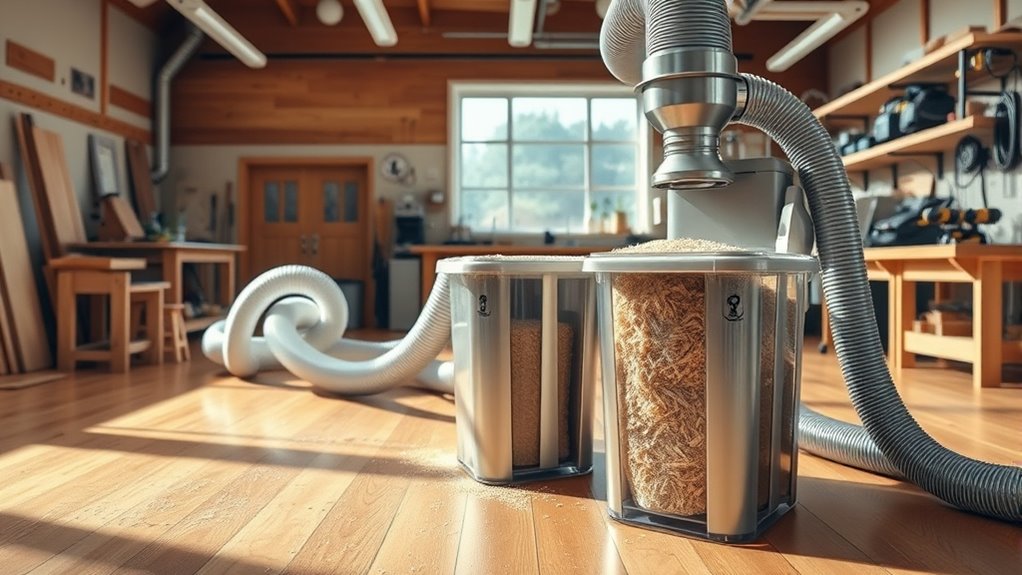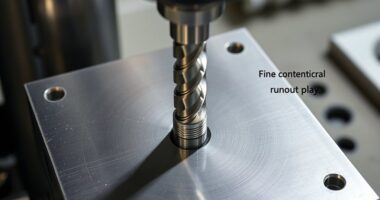To set up a clean, safe workshop, start by choosing a dust collection system that matches your space and tools. Capture dust at the source near saws and sanders, and make certain filters—preferably HEPA—are regularly maintained. Position air filtration units to improve overall air quality and incorporate venting options like outside exhaust. Properly installed and maintained systems keep dust levels low and meet safety standards. Keep exploring to learn how to optimize your dust collection setup effectively.
Key Takeaways
- Assess workshop size and layout to design an appropriately sized dust collection system.
- Capture dust at the source near tools like saws and sanders for maximum efficiency.
- Select high-efficiency filters, such as HEPA, to remove microscopic dust particles effectively.
- Regularly inspect and maintain filters, ductwork, and equipment to ensure optimal performance.
- Position air filtration units strategically to improve overall air quality and meet safety standards.

Have you ever wondered how to keep your workshop clean and safe while working with wood and other materials? One of the most effective ways is by setting up a reliable dust collection system. Dust can quickly become a hazard, not just by creating a mess but also by endangering your health and violating safety regulations. Proper air filtration is a critical part of this process because it guarantees that airborne dust particles are captured before they can circulate in your workspace. When you install a dust collection system, you’re actively reducing the amount of dust in the air, making your environment safer and more comfortable to work in.
To start, you need to understand the importance of adhering to safety regulations. These guidelines are put in place to protect you from health risks associated with dust inhalation and fire hazards. Many local and national safety standards specify the minimum requirements for dust collection and air filtration systems in woodworking shops. Making sure your setup complies with these rules isn’t just about legality; it’s about your health and safety. Check with OSHA or other relevant authorities to understand the specific regulations in your area. Installing the right equipment, maintaining it properly, and using dust collection systems that meet or exceed safety standards will help you stay compliant and safeguard your workspace.
When setting up your dust collection system, consider the size and layout of your workshop. Your system should be capable of capturing dust at the source, meaning near your saws, sanders, and other tools. This prevents dust from settling on surfaces or becoming airborne. A good air filtration unit, such as a high-efficiency particulate air (HEPA) filter, can considerably improve air quality by trapping very small particles. These filters are essential for removing microscopic dust that standard systems might miss, especially when working with fine woods or finishes. Properly positioned air filtration units, combined with dust collectors that vent outside or into a filtration booth, keep the air cleaner and safer. Incorporating quality assessment into your setup ensures your equipment performs optimally and maintains compliance with safety standards.
It’s also essential to regularly inspect and maintain your dust collection system. Filters need to be cleaned or replaced as recommended by the manufacturer to guarantee peak performance. A well-maintained system not only complies with safety regulations but also operates more efficiently, saving you time and effort. Remember, neglecting regular upkeep can lead to system failures, increased dust levels, and potential safety hazards. So, make it a routine to check filters, inspect ductwork, and clear out any blockages.
Frequently Asked Questions
How Do I Choose the Right Size Dust Collector for My Workshop?
To choose the right size dust collector, consider your workshop’s dust collector capacity needed for effective air filtration and debris collection. You should also pay attention to hose diameter selection—larger hoses handle more airflow, improving suction. Measure your tools’ dust output and match it with a dust collector that offers enough CFM (cubic feet per minute) capacity. This guarantees efficient cleanup and a cleaner workspace.
What Safety Precautions Should I Take When Installing a Dust Collection System?
Did you know that improper dust collection can increase respiratory issues by up to 30%? When installing your system, always wear personal protective equipment like masks and goggles. Guarantee electrical safety by turning off power and checking wiring before connecting. Keep work areas clear of clutter, and follow manufacturer instructions carefully. These precautions protect you from dust exposure and electrical hazards, making your workshop safer and healthier.
How Often Should I Maintain and Clean My Dust Collection System?
You should clean and maintain your dust collection system at least once a month, or more often if you notice reduced suction. Regular filter maintenance is essential to keep airflow ideal, so check and replace filters as needed. Conduct system inspections to identify any leaks or blockages. Staying consistent with these tasks ensures your system works efficiently, keeps your workshop clean, and maintains safe air quality.
Can I Connect Multiple Machines to a Single Dust Collector?
Imagine a network of hoses weaving through your workshop, connecting multiple machines to a single dust collector. Yes, you can do this, but proper hoses management is key. Keep hoses clear of kinks and make certain each machine’s airflow is balanced to maintain filtration efficiency. If one machine dominates airflow, others will suffer. Regularly check connections and adjust as needed to keep dust moving smoothly and your system running efficiently.
What Are the Signs My Dust Collection System Needs Repair or Upgrading?
You’ll notice your dust collection system needs repair or upgrading if filter efficiency drops, causing dust buildup or more airborne debris. Reduced airflow, strange noises, or inconsistent suction also signal issues, often due to airflow restrictions or clogged filters. If you find dust escaping or your system struggles to handle the workload, it’s time to inspect filters, clear blockages, or consider upgrading components to restore peak performance.
Conclusion
With the right dust collection system in place, you’re creating a shield that protects your workshop’s heart—your craftsmanship. It’s like planting a protective tree, its roots grounding your space in cleanliness and safety. As you build this system, you’re nurturing a healthier environment where your skills can flourish without the shadow of dust. Embrace this setup as your workshop’s guardian, ensuring every project begins with clarity and ends with pride.









